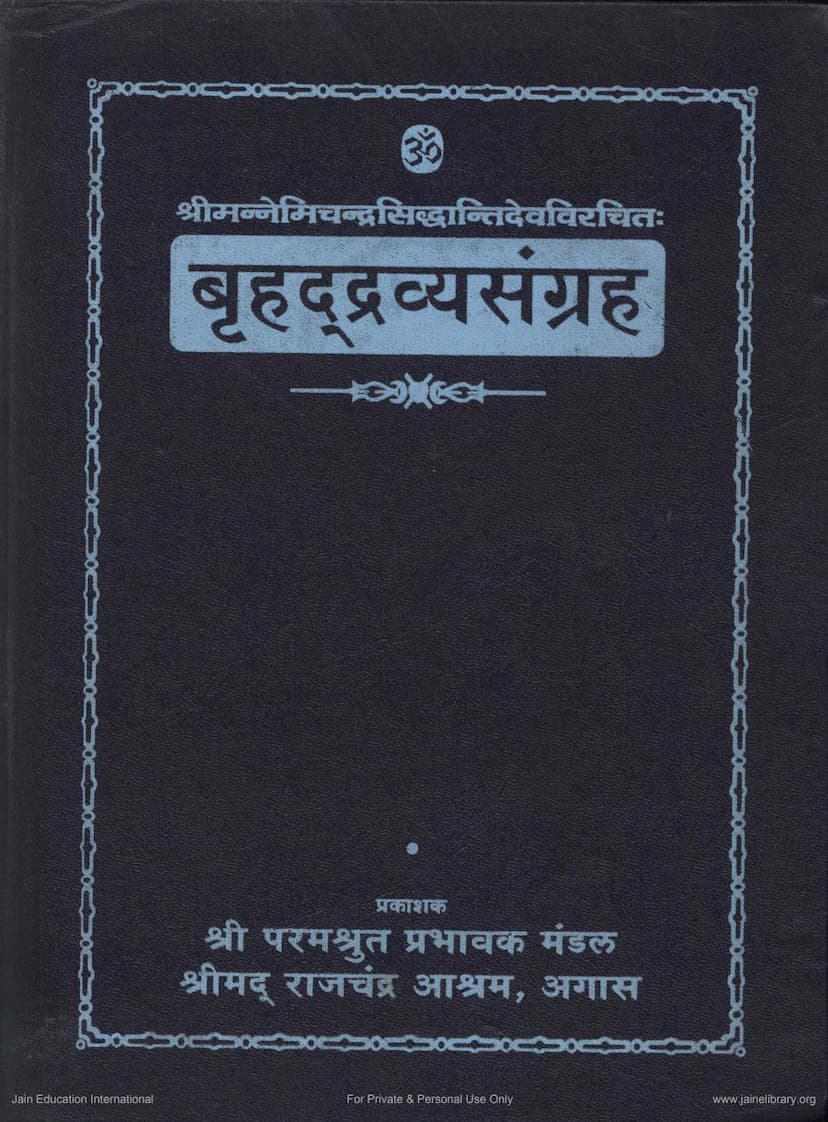Bruhaddravyasangrah
Added to library: September 1, 2025

Summary
The provided text is an introduction and partial summary of the Jain text "Bruhaddravyasangrah" (Great Collection of Substances) authored by Nemichandrasuri, with Sanskrit commentary by Brahmadeva and Hindi translation and revision by Jawaharlal Shastri. The document details the historical context, authorship, and philosophical content of the work.
Here's a comprehensive summary in English:
Book Title: Bruhaddravyasangrah (बृहद्रव्यसंग्रह) Author: Nemichandrasuri (श्रीमन्नेमिचन्द्रसिद्धान्तिदेव) Publisher: Paramshrut Prabhavak Mandal (श्री परमश्रुत प्रभावक मंडल) Publisher Address: Shrimad Rajchandra Ashram, Agas, Gujarat. Language: The text is primarily in Hindi, with the original Sanskrit commentary and Prakrit verses from the core text.
Key Information and Summary:
-
Significance of the Text: Bruhaddravyasangrah is a highly revered Jain scripture, considered as important and useful as the Tattvartha Sutra. It is widely studied in Jain schools, and even young students memorize its verses.
-
Authorship and Origin:
- The text is attributed to Acharya Nemichandrasiddhantichakravarti, a prominent Jain scholar.
- According to the commentary, Acharya Nemichandra initially composed a "Laghu Dravyasangrah" (Small Collection of Substances) consisting of 26 verses (excluding the initial salutation). Later, he expanded upon it with more detailed explanations to create the "Bruhaddravyasangrah."
- The introduction provides a biographical sketch of Acharya Nemichandra, placing him in the Nandi Sangha, Deshiya Gana, in the 7th century CE (Vikram Samvat 735). It highlights his connection with King Rajamalla and his minister Chamundaraya (also known as Gommateshwara or Chamundaraya), who commissioned the famous Gommateshwara statue. Nemichandra is credited with other significant works like Gomattasara, Labdhisara, and Trilokasara.
-
Content and Structure:
- The "Bruhaddravyasangrah" is a compilation of 58 verses in total, divided into three main sections or 'Adhikaras' (chapters):
- First Adhikara (Chapters): Deals with the general description of the six substances (dravyas) – Jiva (soul), Pudgala (matter), Dharma (medium of motion), Adharma (medium of rest), Akash (space), and Kala (time). It contains 26 verses (including the salutation). This section is further divided into three sub-sections: Jiva (14 verses), Ajiva (8 verses), and Panchastikaya (5 verses).
- Second Adhikara: Focuses on the 'Saptatattva' (seven realities) and 'Navapadartha' (nine categories), explaining concepts like Asrava (influx), Bandha (bondage), Samvara (suppression of influx), Nirjara (shedding of karma), and Moksha (liberation). It comprises 11 verses.
- Third Adhikara: Primarily discusses the 'Moksha Marga' (path to liberation), elaborating on Samyagdarshan (right faith), Samyagjnana (right knowledge), and Samyakcharitra (right conduct). It contains 20 verses. The section also covers topics like meditation (Dhyana) and the nature of the five supreme beings (Panch Parameshti).
- The "Bruhaddravyasangrah" is a compilation of 58 verses in total, divided into three main sections or 'Adhikaras' (chapters):
-
Commentaries and Translation:
- The text includes a Sanskrit commentary (Vritti) by Brahmadeva, who is estimated to have lived in the mid-16th century CE. Brahmadeva's commentary is praised for its simplicity and clarity, making the complex spiritual subject matter accessible. It also cites evidence from other important Jain scriptures to support its points.
- The Hindi translation and revision were done by Pandit Jawaharlal Shastri. The preface to this edition discusses the importance of translating Sanskrit scriptures into vernacular languages for the benefit of the general public. Shastri emphasizes that this is the first comprehensive Hindi translation of this work and explains his approach to translation, aiming for clarity and fidelity to the original text. He also notes the collaborative effort involved in producing this edition.
-
Philosophical Approach: The commentary highlights that the text primarily follows the Nishchaya Naya (ultimate or absolute truth perspective), focusing on the pure, inherent nature of the soul. However, it also incorporates Vyavahara Naya (conventional or practical truth perspective) where necessary to explain spiritual concepts more practically, illustrating the Jain principle of Anekanta (non-absolutism) and the integration of different perspectives. The text is considered an excellent work for understanding spiritual truths.
-
Historical and Contextual Information: The preface delves into the historical background, providing details about Acharya Nemichandra's life, contemporaries, and the patron kings and ministers who supported Jain literature. It also references other historical accounts and inscriptions to validate the timeline and contributions of these figures.
-
Editions and Availability: The text is published by the Paramshrut Prabhavak Mandal as part of the Shrimad Rajchandra Jain Shastramala. The preface mentions multiple previous editions, indicating its ongoing relevance and readership.
In essence, the provided document serves as an in-depth introduction to "Bruhaddravyasangrah," offering insights into its profound philosophical teachings, its revered author, and the dedicated efforts made to preserve and disseminate this vital Jain scripture through detailed commentaries and translations.